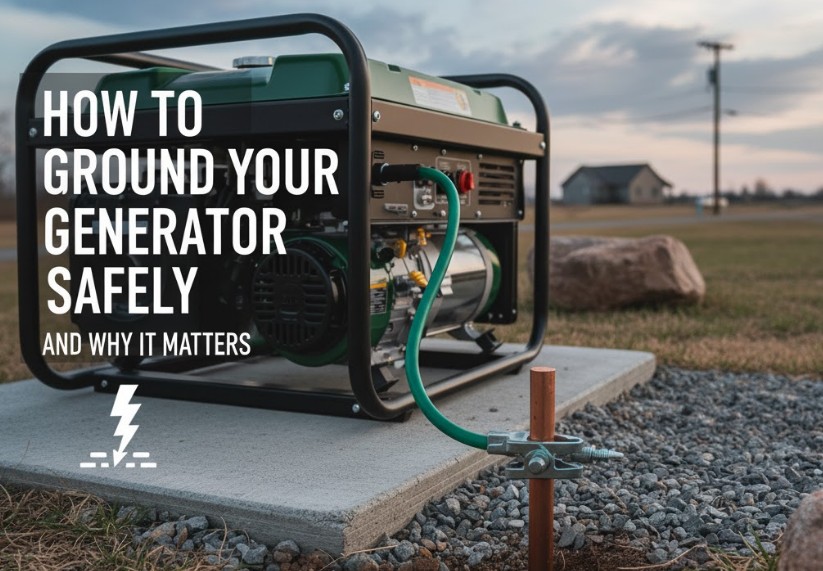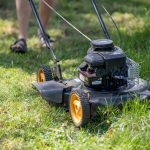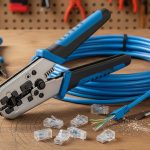A generator is a lifeline during a power outage, providing the essential electricity needed to keep lights on, refrigerators running, and critical medical equipment operational. However, this powerful convenience comes with a critical safety mandate: proper grounding. Whether you own a small portable unit or a large home standby system, understanding how to ground your generator safely is not just recommended—it’s absolutely essential for preventing severe electric shock, safeguarding your appliances, and complying with electrical codes. This comprehensive guide will walk you through the essential steps, the “why,” and the “how” of generator grounding, ensuring your setup is both functional and safe.

Why Generator Grounding Is Non-Negotiable
Before diving into the practical steps, it’s vital to grasp the core principle behind grounding. The purpose of a ground, or earthing, connection is to provide a safe, low-resistance path for fault current to travel, diverting it away from people and sensitive equipment. Think of it as an electrical escape route.
The Hazards of an Ungrounded Generator
Operating an ungrounded generator poses several risks, the most serious being electric shock. If an internal fault occurs within the generator—for instance, if a hot wire touches the metal frame—the entire casing can become energized. Without a grounding path, the current has nowhere to go. If you touch the generator while standing on the ground, your body becomes the path to ground, resulting in a potentially lethal shock. Furthermore, proper grounding helps:
- Prevent Equipment Damage: It stabilizes voltage, protecting connected appliances and tools from surges and fluctuations.
- Trip Internal Circuit Protection: A ground connection ensures that circuit breakers or fuses can quickly interrupt the flow of fault current, shutting down the generator before damage occurs.
- Meet Code Requirements: The National Electrical Code (NEC) specifies strict rules for generator grounding that must be followed for legal and safe operation.
Understanding Generator Neutral Types: Bonded vs. Floating
The first and most critical step in determining how to ground your generator safely is identifying its neutral configuration. Generators come in two main types:
1. Generators with a Bonded Neutral (Non-Separately Derived System)
In a bonded neutral generator, the neutral wire is electrically connected (bonded) to the generator’s frame. Most small, portable generators—especially those with GFCI (Ground Fault Circuit Interrupter) outlets—are manufactured this way. The frame itself serves as the grounding electrode conductor path. This type of generator is considered a “non-separately derived system” when connected to a home via a transfer switch.
- Rule: If you are plugging appliances directly into a bonded generator’s outlets, the NEC generally states that no external grounding rod is required. The grounding is accomplished through the cord and the frame.
- Exception: If you are connecting a bonded generator to a home’s electrical system via a transfer switch, the generator’s neutral-to-frame bond must often be isolated or removed by a qualified electrician, as only the main service panel should have the single neutral-to-ground bond.
2. Generators with a Floating Neutral (Separately Derived System)
In a floating neutral generator, the neutral wire is NOT connected to the generator’s frame. These are commonly larger portable generators or many home standby units. This configuration is considered a “separately derived system” when connected to a home.
- Rule: A floating neutral generator absolutely requires an external grounding rod (or other approved grounding electrode) when operating as a standalone power source (i.e., not connected to a building’s electrical system via an approved transfer switch). The grounding rod completes the necessary safety path.
How to Check Your Generator’s Neutral Type
Consult your generator’s owner’s manual. The manufacturer will clearly specify whether it has a bonded or floating neutral. If the manual is lost, you can use a multimeter to check continuity between the neutral pin on an outlet and the metal frame. Continuity indicates a bonded neutral; no continuity indicates a floating neutral.
Step-by-Step Guide on How To Ground Your Generator Safely
If you have determined that your generator (most commonly a floating neutral model) requires an external ground, follow these precise steps. This procedure is critical for safe operation.
Step 1: Gather the Necessary Equipment
To establish a compliant ground, you will need the following materials:
- Ground Rod: This is typically an 8-foot (2.4 meter) long copper or copper-clad steel rod. The NEC requires a minimum length and specific material. You can find more details on grounding rods here: Ground Rod Information.
- Grounding Wire: A heavy-gauge, insulated copper wire (usually 10- or 8-gauge, green insulation is standard) sufficient to reach from the generator to the rod.
- Ground Rod Clamp: A specialized brass or copper clamp used to securely fasten the grounding wire to the ground rod.
- Tools: A sledgehammer for driving the rod, a wire cutter/stripper, and a wrench for tightening the clamp.
Step 2: Position the Generator and Rod
Place your generator in a safe, outdoor location away from doors, windows, and vents to prevent carbon monoxide poisoning. The grounding location should be as direct as possible. Drive the ground rod into the earth near the generator.
- Driving the Rod: Use a sledgehammer to drive the rod straight down until only a few inches remain above the soil. This ensures maximum contact with the earth. If you hit rock, the NEC allows you to angle the rod up to 45 degrees, or in very rocky soil, bury it horizontally in a trench 30 inches deep.
Step 3: Make the Connections
With the ground rod securely in place, you can now make the electrical connections:
- Attach Wire to Rod: Strip an inch or two of insulation from one end of the grounding wire. Thread the bare wire through the ground rod clamp and tighten the clamp securely onto the ground rod. Ensure a firm, low-resistance connection.
- Attach Wire to Generator: Locate the designated grounding lug on the generator frame. This is usually a green-colored screw or bolt terminal clearly marked with a ground symbol ($\text{\o}$). Securely fasten the other end of the grounding wire to this lug.
Once connected, you have established the required low-resistance path for fault current. Always double-check that both connections are tight and secure.
Grounding for Home Integration: Transfer Switches and Safety
When you connect a generator to your home’s wiring system—a practice that requires a professionally installed manual or automatic transfer switch—the grounding requirements change and become more complex. You are no longer just powering cord-connected tools; you are interacting with your entire household electrical system.
The Importance of a Transfer Switch
A transfer switch is arguably the most critical component for safe home generator backup. It serves two vital functions:
- Prevents Backfeeding: It isolates your home’s wiring from the utility grid, preventing dangerous “backfeeding” of power onto utility lines. Backfeeding can electrocute utility workers attempting to restore power.
- Manages Grounding/Neutral: It ensures that your electrical system maintains a single, correct neutral-to-ground bond, whether running on utility power or generator power.
For large-scale or long-term backup, consider professional solutions like these: Best Whole House Generators, or Best Home Standby Generators.
Connecting a Portable Generator to a Home System
For those using mid-sized portable units, the rules are often dictated by the design of the transfer switch or inlet box and the generator’s neutral configuration:
- Bonded Neutral Generator: If your bonded portable generator is connected to the house via a switch, an electrician must often modify the generator to float the neutral so that the home’s main panel remains the sole neutral-to-ground bonding point. If the generator cannot be modified, a 3-pole transfer switch may be required to switch both the hot and neutral conductors.
- Floating Neutral Generator: This is generally the simpler configuration for home hookup, as the home’s main service panel maintains the required neutral-to-ground bond. The generator relies on the home’s existing grounding system. No additional external grounding rod is required for the generator itself in this specific scenario.
For portability and ease of use, you might be interested in these options: Best Portable Home Backup Generators or Best Inverter Generator for Home Backup.
Frequently Asked Questions on Generator Grounding
Q: Can I skip the ground rod if I have GFCI outlets?
A: For a small, bonded neutral portable generator where you are *only* plugging extension cords directly into the GFCI outlets, the NEC generally permits operating without an external ground rod. The GFCI protects against shock by monitoring current imbalance, while the bond to the frame offers the fault path. However, if you are using a non-bonded (floating neutral) generator, or connecting to a structure, the ground rod is always required.
Q: What if I can’t drive an 8-foot rod?
A: As mentioned, the NEC permits you to angle the rod up to 45 degrees. If this still fails, you may be permitted to use two 8-foot rods placed a minimum of 6 feet apart, or you may be allowed to bury the rod horizontally in a trench at least 30 inches deep. Always consult local codes.
Q: Are solar generators or battery backups required to be grounded?
A: Solar generators (battery backup systems with integrated inverters) are governed by different rules. Most popular models use a high-quality inverter that includes internal bonding and sophisticated ground fault circuitry. When used as standalone, cord-connected appliances, they typically do not require an external grounding rod. However, if you connect a solar generator to your home’s electrical panel via a critical load subpanel and an approved transfer switch, the grounding is handled by the home’s existing system. For options in this area, see: Best Solar Generators for Home Backup.
Q: Does the generator have to be off when I connect the grounding wire?
A: Absolutely. Never attempt to connect or disconnect the grounding wire while the generator is running or under load. Turn the generator completely off, remove all loads, and only then proceed with grounding connections. This is a fundamental safety precaution to prevent arc flash and severe injury.
Final Thoughts
Understanding how to ground your generator safely is the single most important step you can take to protect yourself, your family, and your property when using backup power. The proper procedure hinges entirely on knowing your generator’s neutral type and whether you are using it as a standalone unit or connecting it to your home’s electrical system via a transfer switch. While the specifics can sometimes seem confusing, always err on the side of caution. If you are ever in doubt about the correct grounding procedure for your specific setup—especially when involving your home’s wiring—it is highly recommended to consult a qualified, licensed electrician. Safety is the priority; never compromise it for convenience.
Amranul is a highly experienced product review writer with a passion for helping readers make smart, informed purchasing decisions. Since 2018, he has specialized in thoroughly researching and analyzing a wide range of products to deliver honest, in-depth reviews. Amranul combines technical accuracy with clear, engaging writing to break down complex product features and highlight true user value. Look for his reviews to find reliable information and expert insights you can trust before you buy!





